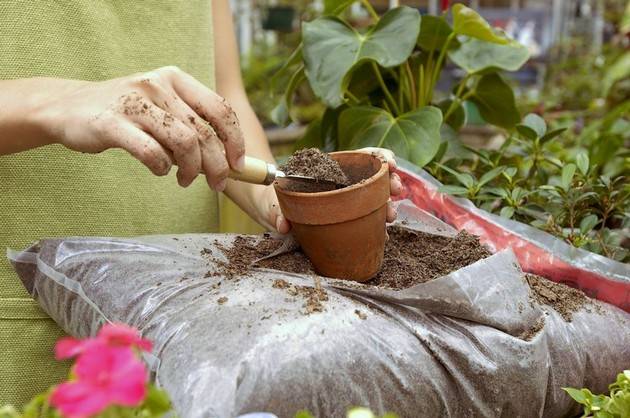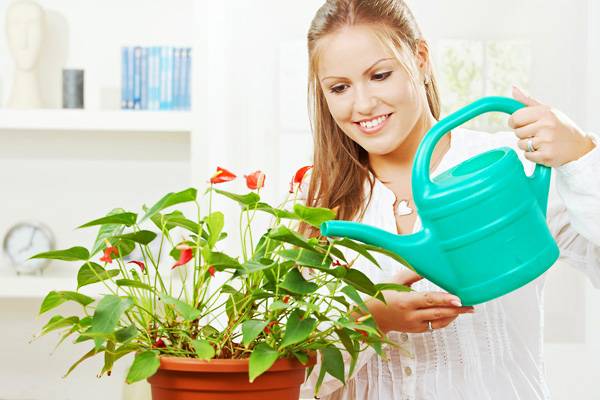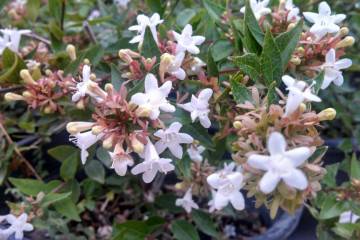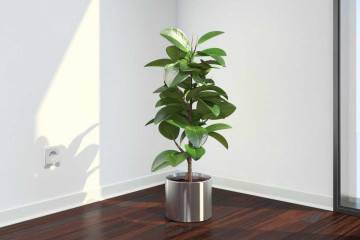Caring for indoor plants at home
Content:
Houseplants require special attention to themselves, as to a child. Any mistake in grooming can negatively affect the healthy development of the flower. It is necessary to provide proper care and favorable conditions starting from the very initial stage - planting in a container. And then, throughout the life of a flower, monitor it, maintain health and well-being.
What to do with potted flowers after purchase
How to care for indoor plants after they have appeared in the house? First of all, it is necessary to create the necessary conditions for growing. Each plant is unique and requires its own care rules. However, in general, the order of measures taken is not very different from each other.
Do not rush and after buying a flower, immediately start planting it in the ground. Any transplant is stressful, especially after transportation and abrupt changes in the environmental conditions of the seedling. It is necessary to gradually allow the bush to get used to the new conditions within 3 weeks. If the plant was purchased in winter, then transplanting into a permanent container is best done at the end of February.
Plant transplant
A transplant is necessary for indoor flowers not only after buying a seedling, but also during the growth period, especially in the early years. The plant is actively growing, and its root system is expanding.
House flowers are usually transplanted using the transhipment method. In this case, it is necessary to monitor the state of the root system. Any, even minor damage to the roots can negatively affect the condition of the bush as a whole. It is through small cracks that the plant becomes infected with infectious diseases and fungus.
The plant is planted so that the base of the stem is no more than 2 centimeters below the top of the pot. Sprinkle the earth neatly along the edges and lightly tamp it with your hands. When filling up the earth, it is necessary to constantly tap on the sides of the container so as not to leave empty spaces. After planting, the bush is watered abundantly and a layer of fertile soil is poured on top.
Using a double pot when growing home flowers
Double bottom pots help improve the drainage system.
Such containers are suitable for both drought-resistant and moisture-loving plants. The design consists of two pots that are put on top of each other. The inner container is not as deep as the outer one and has a mesh bottom. The outer pot has a drainage layer at the bottom.
When watering, excess moisture flows into the lower pot without stagnating in the ground.
We select drainage
Expanded clay crumbs are used as drainage, which is covered at the bottom of the pot. But the drainage material does not always save the soil from waterlogging, so you need to regularly loosen the soil by hand.
We select an earthen mixture
A high-quality and useful substrate is the main rule of transplantation. It must be loose and slightly damp. Tropical species of ornamental deciduous plants, such as Kalanchoe, are especially demanding on breathable and moist soil. Bulbous and cacti, lily and Decembrist, on the contrary, get sick from too wet soil.
An earthy mix usually contains fertile soil of the required acidity level, sand or peat, and fertilizers. It is impossible to allow the ingress of low-quality and contaminated soil, which in the future will provoke the appearance of diseases in plants.
Root formation stimulants - types, methods of application
Stimulants help cuttings take root during plant propagation and strengthen the root system as a whole. These preparations contain special biological active substances called phytohormones.
The most famous types of root stimulants:
- adaptogens - popular rooters "Heteroauxin", "Kornerost", "Epin", "Kornevin".
- natural preparations that contain indoleacetic acid;
- synthetic analogs of natural drugs;
- growth regulators;
- folk stimulants: willow water, bee honey, aloe juice.
Rooters are applied in the form of a solution in which the root of the seedling is placed before planting.
Indoor flowers and their care
Before purchasing and planting in a pot, you first need to have knowledge of how to care for home flowers correctly. Since the rules for caring for them may differ. For example, plants with fleshy and succulent leaf blades can do without frequent and abundant watering, while flowers with large thin leaves need it very much. Bulbous ones suffer from excess moisture, moreover, it is impossible to directly water the soil near the bulb, the plant can get sick with a fungus.
Air humidity
For deciduous plants, high air humidity is very important. If the atmosphere around the flower is dry, the humidity is artificially increased. For this, regular spraying of the ground part of the bush from a spray bottle is usually carried out.
It is also permissible to put flat containers of water near the plant.
Lighting
Taking good care of your indoor plants means creating the right lighting. There is enough sun in the summer, but sometimes it is in abundance. During such periods, flower pots are transferred to more shaded places or placed on the northern and eastern windowsills. In general, they try to make sure that direct sunlight does not fall on the flower at noon. Especially if the impact is through transparent glass.
In winter, natural light is not enough, especially for light-loving crops. Therefore, it is necessary to create artificial lighting. For this, both ordinary lamps and special phytolamps are used.
Required temperature conditions and ventilation
In caring for home flowers, the temperature of the content is of great importance. It is the moderate and recommended temperatures for plants that play the most key role in the healthy growth of flowers. They grow well and start flowering on time. At the same time, excessive temperature rise should not be allowed.The optimal temperature regime for indoor ornamental plants is from 15 to 30 degrees. More precisely, you can say only after studying the description of a particular flower.
Summer watering and spraying
During the summer, the main change in plant care is frequent and abundant watering. It must be carried out with soft, settled water, not tap water.
In summer, water should not be allowed to enter the leaf plates, otherwise the plant will get burns under the scorching sun. In addition, after each watering, it is necessary to loosen the soil in the pot so that the moisture does not have time to stagnate.
Winter care regimen
In winter, the plant is allowed to rest and is not disturbed unnecessarily. At this time, the frequency of watering and feeding is reduced. When dried and rotten leaves and stems appear, they are pruned.
Feeding indoor plants with nutrients
The plant receives the nutrients necessary for growth through the root system from the soil. Therefore, feeding must be carried out regularly. The first application of fertilizers takes place even during planting of plants in containers. Then the fertilizer is included in the planting substrate.
As part of top dressing for home cultivation, the following elements must be present:
- nitrogen - is a part of proteins and chlorophyll, it is necessary to build up green mass;
- phosphorus - important for energy processes in cells;
- potassium - an assistant in the assimilation of carbon dioxide, participates in nitrogen metabolism;
- sulfur is the main source of protein building;
- calcium - plays a key role in nitrogen and carbohydrate metabolism;
- magnesium is a participant in photosynthesis;
- iron is the main participant in the formation of chlorophyll and proteins; it is poorly absorbed in alkaline soils;
- boron - forms a scheme of cell walls and participates in the synthesis of nucleic acids;
- manganese - participates in photosynthesis;
- copper - plays an important role in the synthesis of carbohydrates and proteins, increases immunity against fungal diseases.
As soon as there is a deficiency or excess of minerals, the plant immediately changes in appearance and development in general.
What fertilizers exist for indoor flowers
Fertilizers are divided into organic and mineral fertilizers. Organic fertilizers include natural fertilizers of animal origin - manure, bird droppings, compost, rotted foliage and peat. Mineral fertilizers include potash, nitrogen, phosphorus preparations.
For top dressing, special complex preparations are used, and also folk recipes are used. Store drugs come in the following consistencies:
- powdery;
- liquid;
- in the form of tablets;
- granular;
- pressed.
What fertilizers and when to feed indoor plants
Basically, fertilizing is carried out with liquid fertilizers, since they are better and faster absorbed. The first feeding is carried out in spring in March, it should prepare and provide the plants with the substances necessary for active growth and budding. For this, nitrogen fertilizers are used: ammonium sulfate, urea; ammonium and sodium nitrate.
During flowering, potash fertilizers are useful: potassium nitrate and potassium sulfate. From folk methods, wood ash can be used. After flowering, phosphorus and organic fertilizers are added to the usual dressings.
In winter, the amount and regularity of fertilizing is reduced, since due to the plant leaving for dormancy, active growth and absorption of nutrients slows down.
How to keep flowers on vacation
During the holidays, one of the main women's problems is the unattended flowers left and taking care of them. Not everyone has the opportunity to leave home vegetation under the supervision of family and friends, because in the summer, every weekend is important on the calendar, which is worth its weight in gold. If plants in the garden can be left unattended for a month, then in indoor conditions this is unlikely.
In order for the flowers to stand for a whole month without watering, you need to do the following:
- carry out abundant watering, followed by loosening of the soil;
- draw the curtains on the windows to avoid prolonged exposure of flowers in direct sunlight;
- erect young bushes can be wrapped in damp newspaper and wrapped in a bag;
- cut off the buds and some leaves to reduce the evaporation area;
- to keep the humidity at a high level, all flower pots must be placed as close to each other as possible.
Diseases and pests
Indoor flowers, as well as garden flowers, are susceptible to disease. The main causes of diseases and pests are unfavorable growing conditions and improper care. Most diseases are not transmitted to other plants. However, this does not exclude the fact that the plant may die. Damage to the root system is especially dangerous; in these cases, the prospect of getting a dried plant is obvious.
Deciduous flowers such as gloxinia or tradescantia often develop chlorosis. The leaf plates begin to turn yellow and dry out due to the violation of the formation of chlorophyll. The reason for this behavior is the lack of minerals in the soil.
Common indoor flower diseases:
- anthracnose;
- powdery mildew;
- blackleg;
- gray rot;
- leaf spot;
- dropsy.
Indoor flowers suffer from the attacks of aphids, scale insects, powdery mildew, spider mites. Pests are fought by insecticide treatment.
Unlike field bells or garden birches, house flowers are especially in need of care. Since, sometimes, plants brought from other continents are not adapted to more severe climatic conditions. Sometimes even exotic trees have to be grown under artificial conditions. Therefore, proper care must be provided for their healthy growth.






















